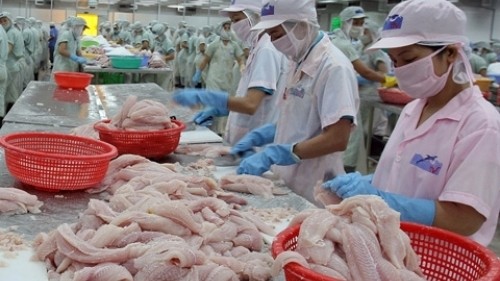Bright prospects
As a comprehensive agreement with a high level of commitment and a balance of advantages for both sides, the VKFTA is expected to bring about many positive benefits to Vietnam. Under the trade pact, the ROK will liberalise 97.2% of its imports (according to 2012 data), accounting for 95.4% of tariff lines, including many of Vietnam’s key agricultural and fishery exports such as shrimp, crab, fish, tropical fruit, and manufactured goods such as clothes, timber and mechanical products. Vietnam is the first FTA partner with which the ROK will open its market for sensitive goods such as garlic, ginger, honey and sweet potatoes, which are usually taxed at rates between 241% and 420%. This gives Vietnam’s exports a significant competitive advantage over similar products from China, Indonesia, Malaysia and Thailand. For example, the ROK will exempt tariffs on 10,000 tonnes of Vietnam’s shrimp in the first year, increasing to 15,000 tonnes annually over the next five years, while the quota for ten other ASEAN countries is only 5,000 tonnes per year.
During negotiations on the VKFTA, the two sides also agreed that the ROK would help Vietnam enhance its policy formulation and implementation capacity, and improve competitiveness in areas that are the ROK’s strengths and Vietnam wishes to cooperate such as agriculture, fishery, forestry, electronics, oil refinery and supporting industries. In addition, the VKFTA is expected to bring about positive social impacts by creating more opportunities for Vietnamese workers, raising the incomes of manual and low-skilled workers, and helping with the poverty reduction efforts in rural areas.
Commenting on VKFTA prospects, General Director Pham Xuan Trinh of Phong Phu Corporation, a garment maker, says the trade pact is bound to create more opportunities for Vietnamese exporters in this market. He says Vietnamese garment companies’ three main exports to the ROK are clothes, fibre and fabric, while importing materials from the ROK for their manufacturing. Korean companies also show considerable business acumen as a number of them had travelled to Vietnam to explore the market before the VKFTA was signed. Currently Phong Phu Corporation is shipping more than 200,000 metres of fabric to the ROK each month.
General Director of Soc Trang Fisheries Company (Stapimex) Tran Van Pham says when the tax rates are lowered, it will help the company cut costs and their product prices, making them more competitive. For Ba Ria-Vung Tau Seafood Processing and Export-Import Company (Baseafood), the ROK is an established market. When the VKFTA comes into force, it will likely help the company increase its exports by lower tariffs and securing more partners. A number of small and medium-sized Korean companies, which were previously ineligible to buy Vietnamese goods, can now make their purchases freely thanks to looser requirements, which will help boost Vietnam’s exports.
Le Xuan Duong from the Vietnam Leather, Footwear and Handbag Association (LEFASO) says the ROK market is very large and the country’s enterprises are shifting their manufacturing facilities to a number of countries in the region, including Vietnam. Therefore, in the future the country will rely on imports for the majority of leather and footwear products. The ROK is currently the fifth largest importer of those products. The ROK being one of the largest investors in the leather and footwear sector in Vietnam shows that it is both an exporter of materials and importer of final products. In 2014, Vietnam’s imported materials for the leather and footwear industry were worth US$1.14 billion, with US$200 million from Korean imports. Vietnam also spent about US$17.2 million on purchasing machinery from this market. The same year, it exported US$410 million worth of footwear and handbags to the ROK. Besides cultural similarities and the traditional relationship between the two countries, there are other advantages when doing business with the ROK. The country has strengths in capital, technology and markets, but faces a labour shortage and high labour costs, forcing its companies to shift their manufacturing to Vietnam thanks to cheaper labour and Vietnam’s compliance with the ROK’s demanding requirements.
Numerous challenges
Besides positive impacts, the VKFTA will present many challenges to Vietnam as lower tariffs will put more competitive pressure on Vietnamese enterprises. State management agencies will have to enhance the capacity of its staff so that they can fulfil their duties in an economy operating in accordance with international practices. Local authorities, the business community and people should be more aware of Vietnam’s integration process, and VKFTA implementation in particular, in order to effectively utilise advantages and minimise negative impacts of the trade agreement.
Nguyen Hong Anh, Director of Human Resources at Binh Duong Garment Company, said the ROK is only the intermediary market as most of Vietnam’s exports are not actually sold to Korean consumers. With this agreement, Korean enterprises will seek partners in Vietnam to buy garments to ship to the ROK and then export them to other countries. Chairman and CEO of Gia Dinh Corporation Nguyen Chi Trung also shares the view that the ROK enterprises will benefit when they shift more of their manufacturing activity to Vietnam, while the ROK’s preferential treatment for Vietnam’s agricultural produce is not substantial. It should be noted that the ROK is a large agricultural producer, so when it gives Vietnam such treatment, they will impose technical barriers on Vietnamese produce.
Stapimex General Director Tran Van Pham said the ROK will raise their quality criteria on Vietnamese shrimp. In addition, the export price to the ROK is relatively low compared with other markets in Asia so if the input costs are higher, the increase in profits is not large, even when the import tax is cut. In the future, the ROK will sign free trade agreements with other countries, effectively levelling the tax advantages between countries, so Stapimex still need to be proactive in reducing the prices and enhance the quality of their products in order to compete in the long term.
















